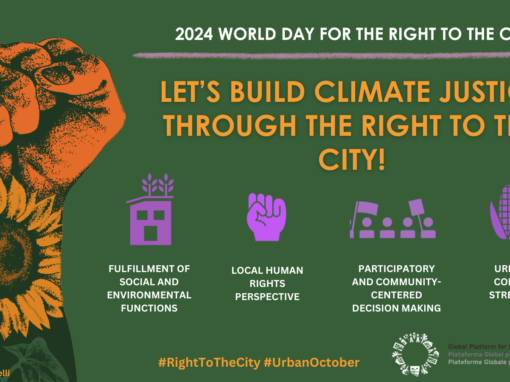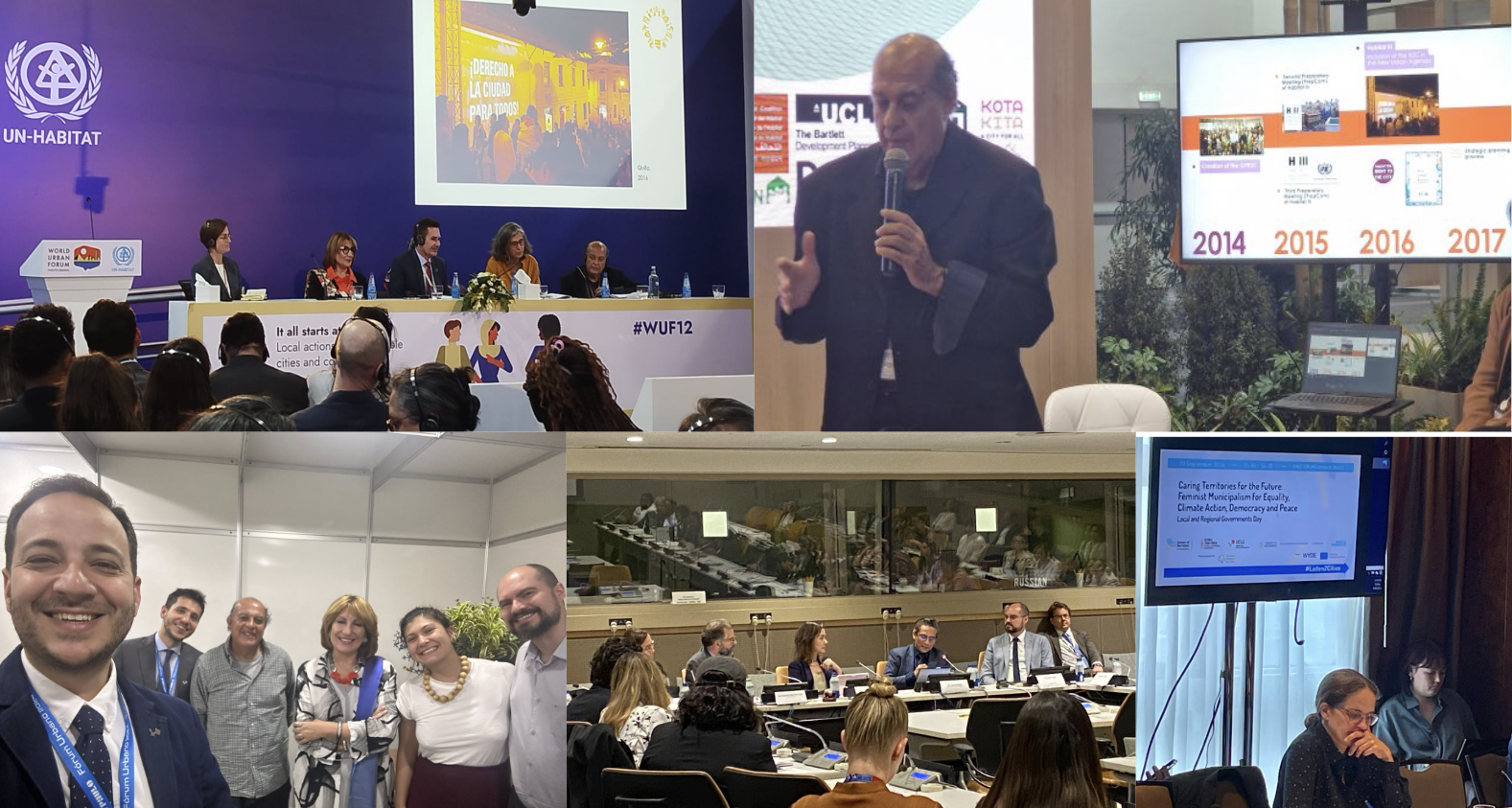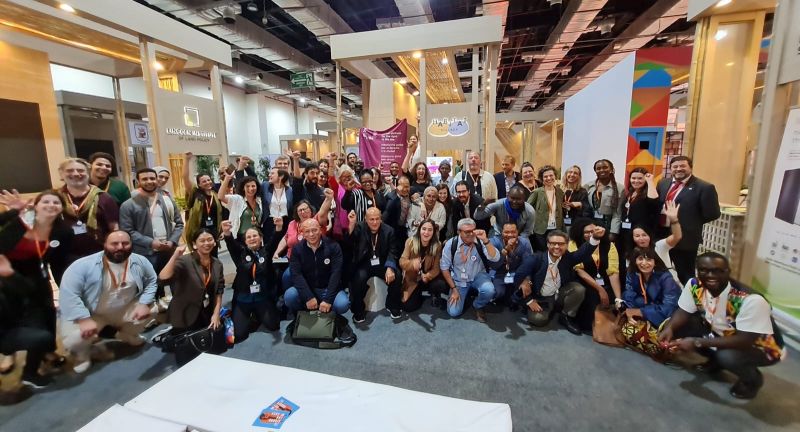Interview with Magali Fricaudet, (Committee on Social Inclusion, Participatory Democracy and Human Rights – UCLG); Sonia Maria Dias (WIEGO – Women In Informal Employment: Globalizing And Organizing); Anaclaudia Rossbach (Cities Alliance); and Jane Katz (Habitat for Humanity International).
HABITAT3 and THE RIGHT TO THE CITY
Habitat3 – The United Nations Conference on Housing and Sustainable Urban Development – took place in Quito, Ecuador, between October 17 – 20, 2016. Several members of the Global Platform for the Right to the City participated in different meetings and offer different points of view on the Right to City before, during and after Habitat3.
“Habitat3 was an opportunity to reaffirm common values in defense of the right to the city, at the confluence between local governments, civil society, UN special rapporteurs on human rights”, declared Magali Fricaudet, coordinator of the Committee on Social Inclusion, Participatory Democracy and Human Rights (UCLG).
“Initially, the Right to the City was very limited to the Latin American context and so I am pleased by the increased representation of Asia and Africa”, affirmed Sonia Maria Dias (WIEGO – Women In Informal Employment: Globalizing And Organizing).
After a long advocacy and negotiation process, the Right to the City was mentioned for the very first time in an UN agreement (The New Urban Agenda). It was a long process that involved several moments of negotiations between countries that were in favor and others against the Right to City in the New Urban Agenda.
“I am convinced that the Right to the City is the biggest innovation of the New Urban Agenda and it was the most discussed topic throughout the Habitat3 process: from taboo and controversial issue at the beginning for a more widespread acceptance at the end”, said Anaclaudia Rossbach (Cities Alliance). For Rossbach, the issue becomes more soundly addressed by governments and organizations, and improved the discussions on its actual implementation by all actors committed to the New Urban Agenda.
POLEMICS and CONTRADICTIONS
The Habitat3 Conference hosted 30,000 people, among them 10,000 international participants from 167 countries. In the span of four days almost 1,000 events took place, including 8 plenary sessions, 6 High-level Roundtables, 10 Policy Dialogues, 22 Special Sessions, 3 Urban Talks, an Urban Journalism Academy, 59 United Nations events, 157 Exhibitioons booths, 42 Village projects and over 460 side, networking, training and parallel events were organized by various stakeholders.
According to Magali Fricaudet, among the variety of actors important contradictions were expressed. “Many multinational and promoters of the Smart City idea, or the idea of Commodification of Cities, were present with a panoply of “ready solutions to be purchased. Therefore, I think now we, as defenders of the right to the city, need to proper monitor the execution of the New Urban Agenda in a participatory way that, in the last instance, benefits the common goods”.
For Sonia Maria Dias, although the New Urban Agenda did not contemplated the Right to the City in its complexity, (“and has made only one mention of it”), it was still a breakthrough given the resistance that many nation-states exercised during the negotiation process. “I think the major challenges now is to strengthen the participation of other countries, increase the participation of popular movements, and implement an agenda that has projects related to the Right to the City – in alignment with the New Urban Agenda”.
GLOBAL PLATFORM FOR THE RIGHT TO THE CITY
The Global Platform for the Right to the City emerged from the initiative of several organizations working on the theme around the world and from the need to promote and mobilize national and local governments, international and regional organizations towards a new paradigm for development, more inclusive and democratic.
The Platform advocate for the recognition and adoption of the Right to the City in the implementation of public policies, therefore it has been participating, through its members, in different spaces and events related to Habitat III process in order to disseminate the concept and to lobby for its adoption as the cornerstone of the New Urban Agenda.
“The Dialogue panel “Right to the City and City for All” had an impressive audience, and the discussions that followed the presentation were very rich in content”, affirmed Anaclaudia Rossbach. “the discussions I participated throughout the preparatory process before Habitat3, in regional events of Policy Units, were much more focused on the definition and conceptual structure of what is the Right to the City. On this panel, diferent actors representing financial institutions, governments and local activists started debating concrete steps towards improving the understanding of the concept from the practice“.
For Sonia Maria Dias, the platform took great move towards having the voices of prominent informal workers. “Several Platform meetings had the participation of the workers themselves. This is very positive as it strengthens the character of “bottom-up” of the Right to the City principles, also responding to criticism that it would be too abstract”.
At Habitat3 Jane Katz (Habitat for Humanity International) was honored to make a statement before the Secretary-General of the UN, Ban Ki-Moon and Dr. Joan Clos, Habitat III Secretary-General, in a private General Assembly of Partners meeting. “While brief, I re-asserted our constituencies belief in the right to adequate housing, security of tenure with no forced evictions, and community-led engagement in the New Urban Agenda”.
“Urban settlements can not remain a source of profit to the detriment of the people, as they have been over the last 20 years”, finally declared Magali Fricaudet. “It is up to us, cities and citizens, to work together to continue defending the territories as common goods”.




